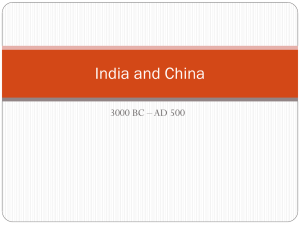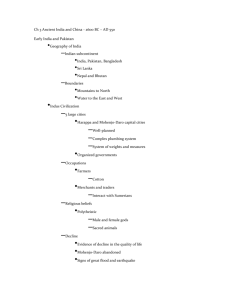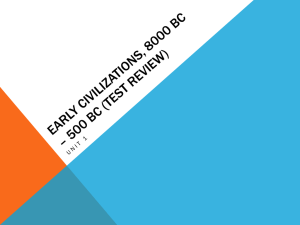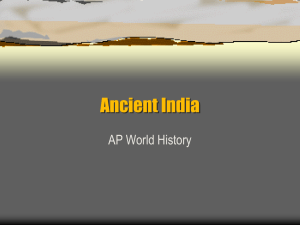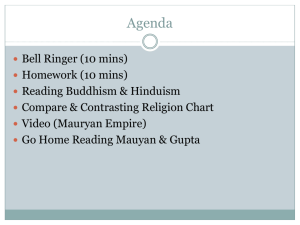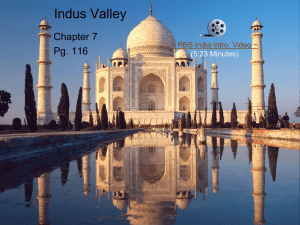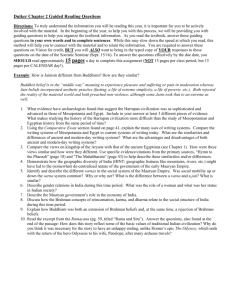Early Civilization in India
advertisement
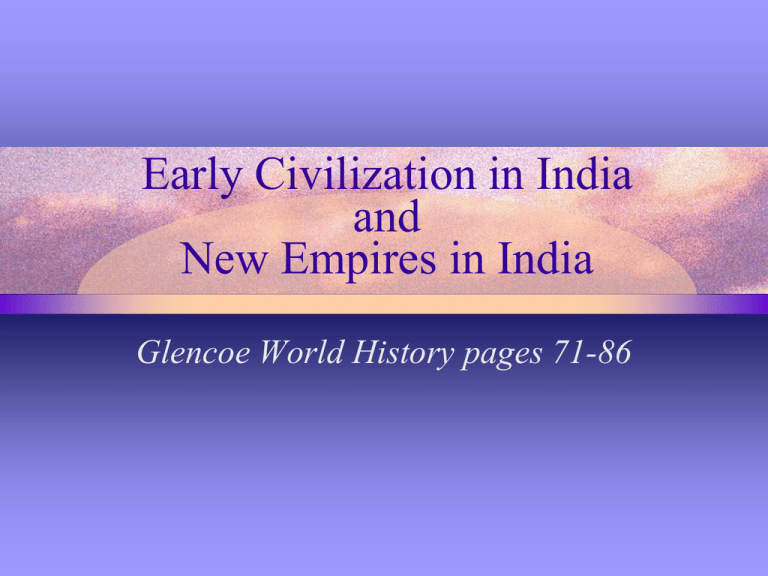
Early Civilization in India and New Empires in India Glencoe World History pages 71-86 Standards • SSWH2 The student will identify the major achievements of Chinese and Indian societies from 1100 BCE to 500 CE. • a. Describe the development of Indian civilization; include the rise and fall of the Mauryan Empire, the “Golden Age” under Gupta, and the emperor Asoka. Enduring Understandings and Essential Questions The student will understand that the culture of a society is the product of the religion, beliefs, customs, traditions, and government of that society. • How did early cultures develop? • What was the impact of religion on the development of early societies? The student will understand that as a society increases in complexity and interacts with other societies, the complexity of the government also increases. • How did the earliest societies create civilizations? • In what ways did the interactions of early civilizations contribute to the greater complexity of their societies? • What was the role of the earliest governments? The student will understand that location affects a society’s economy, culture, and development. • How did the physical features of a region affect the development of the beliefs, customs and traditions of that society? • How did the physical features of a region and limited natural resources necessitate trade between societies? The student will understand that the movement or migration of people and ideas affects all societies involved. • How did migration and movement lead to cultural diffusion? • What changes are brought about by migrations of people? Key Terms • • • • • Sanskrit Caste system Hinduism Karma Buddhism • • • • Aristocracy Mandate of Heaven Silk Road Nirvana Places to Locate • • • • • • • Indian Subcontinent Himalaya Ganges Rivers Deccan Persian Gulf Hindu Kush Indus River India’s First Civilization • Between 3000 and 1500 BCE, the valleys of the Indus River supported a flourishing civilization that extended hundreds of miles from the Himalayas to the coast of the Arabian Sea. • Archaeologists have found remains of more than 1000 settlements in this region. • Two of the ruins about 400 miles apart were sites of what once were the major cities of Harappa and Mohenjo-Daro. An advanced civilization flourished in these cities for hundreds of years. • Historians call it Harappa or Indus civilization. Society in Ancient India • The caste system of ancient India was a set of rigid social categories that determined not only a person’s occupation and economic potential, but also his/her position in society. • In India, the word for caste is jati. There are thousands of jati in India. Social Classes or Varnas In addition to jati, Indian society was broadly divided into 4 social classes called varnas. 1. Brahmans- members of the priestly class 2. Kshatriyas (KSHA-tree-uhz)- warriors. As society changed, they often found new forms of employment. 3. Vaisyas (VYSH-yuhz) – commoners (Most were merchants or farmers) 4. Sudras- Made up the great bulk of the Indian population; Most were peasants and people who worked other at other forms of manual labor The Untouchables • Lowest level of Indian society • Not even considered part of the varna system • Given menial, degrading tasks such as collecting trash and handling dead bodies • Made up about 5 percent of the total population of ancient India • Required to tap two sticks together so that others could hear them coming and avoid them Family in Ancient India • Life in ancient India centered on the family, the most basic unit in society. • 3 generations lived under the same roof. • Males were superior- only males could inherit property and generally were the only ones educated • Children were expected to take care of their parents when they got older • Marriage was arranged • Ritual of suttee required women to throw themselves on the pyre with their dead husbands Harappa and Mohenjo-Daro • At its height Harappa had 35,000 inhabitants and Mohenjo-Daro had between 35-40,000. • Both cities were carefully planned. • Main, broad streets ran north to south. • They were crossed by smaller east to west roads. • Houses were different sizes but all had a square courtyard, surrounded by rooms. Harappa and Mohenjo-Daro •Most buildings were constructed of square, oven baked mud bricks. •Advanced drainage system for bathrooms carrying waste to drainage pits beyond city walls. Rulers and the Economy • As in Egypt and Mesopotamia, Harappan rulers based their power on a belief in divine assistance. • Religion & political power were closely linked. • Harappan economy was based primarily on farming. • Indus River flooded every year, providing rich soil for the growing of wheat, barley, and peas. • This Indus valley civilization carried on extensive trade with city-states in Mesopotamia. • Much of this trade was carried by ship via the Persian Gulf, although some undoubtedly went by land. Mauryan Empire • In 324 BCE, Chandragupta Maurya came to power. He drove out the foreign forces and established his capital in Northern India. • The government was highly centralized. He had a large army and a secret police that followed his orders. • It is rumored that he was always afraid of assassination; ordering all food to be tasted in his sight and never sleeping in the same bed two nights in a row. The Reign of Asoka • Grandson of Chandragupta Maurya • Considered to be the greatest ruler in the history of India • After his conversion to Buddhism, he used these ideals to govern his rule. • The empire flourished during Asoka’s reign • After his death in 232 BCE, the Mauryan Empire began to decline. The Golden Age under Gupta • 320 AD, a local prince Chandragupta (no relation to the earlier Chandragupta Maurya) created a new state in the Central Ganges Valley. • Eventually the new kingdom became the dominant political force throughout northern India. • It established loose control over Central India as well, thus becoming the greatest state in India since the Mauryan Empire. • Under a series of efficient monarchs- especially Chandragupta II, who reigned from 375-415- the Gupta empire created a new age of Indian civilization. Golden Age under Gupta Empire • A Chinese travel Faxian admired the Gupta leaders, their tolerance of Buddhism, • Actively engaged in trade with China, Southeast Asia, and the Mediterranean and encouraged domestic trade. • Cities famous for their temples as well as for their prosperity rose along the main trade routes. • The Gupta rulers lived in luxury and earned large profits from the trade. Hinduism • Originated with the Aryan people who settled in India after 1500 BC • Believed in the existence of a single force in the universe, a form of ultimate reality or God, called Brahman. • By the sixth century BC, the idea of reincarnation had appeared in Hinduism. • Reincarnation is the belief that the individual soul is reborn in a different form after death. Hinduism Continued… • After a number of existences in the earthly world, the soul reaches its final goal in a union with the Brahman. • Important to this process is the idea of karma, the force generated by a person’s actions that determines how the person will be reborn in the next life. • The concept of karma is ruled by the dharma or divine law. The law requires all people to do their duty. Hinduism Continued… • Hindus developed yoga, a method of training designed to lead to union with God • There are hundreds of deities in the Hindu religion, including three chief ones: Brahma the Creator, Vishnu the Preserver, and Siva the Destroyer • Hinduism is still the religion of the vast majority of Indian people today. Siddhartha Gautama or Buddha • The founder of Buddhism was Siddhartha Gautama, known as the Buddha, or Enlightened One. • Siddhartha Gautama was born around 563 BC and was the son of a ruling family. • He was raised in a wealthy family, married and had a child. • He became aware of suffering and gave up his royal clothes, shaved his head, and abandoned his family to find the true meaning of life. Buddhism • Appeared in the sixth century BC • The pain, poverty, and sorrow that afflict human beings are caused by their attachment to things of this world. Once people let go of their worldly cares, pain and sorrow can be forgotten. • Then comes bodhi, or wisdom. • Achieving wisdom is the key step to achieving nirvana, or ultimate reality- the end of self or a reunion with the Great World Soul. Four Noble Truths 1. Ordinary life is full of suffering. 2. This suffering is caused by our desire to satisfy ourselves. 3. The way to end suffering is to end desire for selfish goals and to see others as extensions of ourselves. 4. The way to end desire is to follow the Middle Path. The Middle Path or Eightfold Path • • • • • • • • Right view Right intention Right speech Right Action Right livelihood Right effort Right mindfulness Right concentration Siddhartha Gautama • Rejected Hindu division of human beings into rigidly defined castes • Buddhism appealed to the downtrodden peoples at the lower end of the social scale • Forbade his followers to worship either his person or his image • Many Buddhists therefore see it as a philosophy rather than a religion

